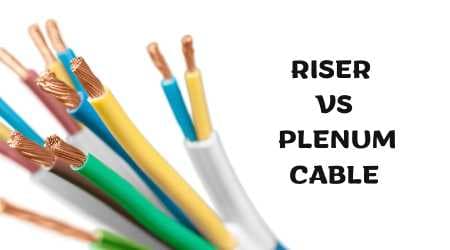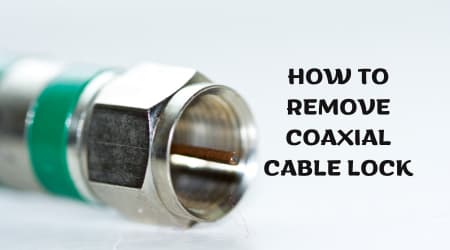
Riser Vs Plenum Cable : Plenum and Riser cables are two types of cables used for different purposes. Plenum cables are used in air handling spaces, such as air ducts. While Riser cables are designed to be used in vertical applications, such as between floors in a building.
When it comes to choosing the right cable for your specific application, it is important to understand the differences between riser and plenum cables. While both cables are designed to meet fire safety codes, plenum cables are made with special materials that are low-smoke and non-toxic, making them suitable for use in air ventilation systems.
Riser cables, on the other hand, are less expensive and are typically used in areas that do not require air circulation. Overall, the choice between riser and plenum cables depends on the specific requirements and safety regulations of your building.
Understanding Riser Cables
Definition Of Riser Cables
Riser cables, also known as vertical cables or backbone cables, are designed and constructed to be used in vertical applications. They are specifically engineered to provide fire resistance and support communication systems within buildings and high-rise structures. Unlike plenum cables, riser cables are not suitable for installation in plenum spaces, which are designated areas for air circulation.
- Riser cables are vertical cables used for communication systems in buildings and high-rise structures.
- They are designed to provide fire resistance and are not suitable for plenum spaces.
Common Uses And Applications Of Riser Cables
Riser cables find various uses and applications in different industries and settings. Here are some common areas where riser cables are commonly employed:
- Telecommunications infrastructure: Riser cables are extensively used in telecommunications networks to connect different floors or levels within buildings.
- Data centers: Riser cables play a crucial role in data centers for vertical connectivity between different server racks and network switches.
- Security systems: Riser cables are used for interconnecting security cameras, access control systems, and alarm systems in buildings.
- Audiovisual installations: Riser cables are employed in audiovisual installations, such as connecting projectors, screens, and speakers in large conference rooms or auditoriums.
Characteristics And Construction Of Riser Cables
Riser cables possess specific characteristics and construction elements that make them suitable for vertical applications. Here are some key features:
- Fire-resistant materials: Riser cables are typically made with fire-resistant materials, usually made of pvc or low smoke zero halogen (lszh) compounds, to prevent the spread of fire in vertical spaces.
- Jacket thickness: The jacket of riser cables is generally thicker than that of plenum cables, offering enhanced protection against mechanical damage and maintaining the integrity of the cable.
- Design considerations: Riser cables are engineered with a focus on vertical installations, ensuring proper signal transmission and compliance with safety regulations.
- Compliance with safety standards: Riser cables have to meet certain safety standards, such as the national fire protection association (nfpa) standards, to ensure their performance in vertical applications.
Benefits Of Using Riser Cables
Using riser cables offers several advantages, making them a preferred choice in vertical applications. Here are some benefits of using riser cables:
- Fire resistance: Riser cables are designed to resist the spread of fire, providing additional safety in vertical spaces. They are built with fire-resistant materials to help inhibit the combustion process and prevent fire from spreading between floors.
- Cost-effective solution: Riser cables are generally more cost-effective than plenum cables, making them a viable option for vertical installations where plenum-rated cables are not required by building codes.
- High-performance signal transmission: Riser cables are engineered to facilitate effective and reliable signal transmission, ensuring optimal communication and connectivity within vertical spaces.
- Durable and long-lasting: With their thicker jackets and robust construction, riser cables are built to withstand harsh environments and mechanical stress, offering long-lasting performance.
- Compliance with safety regulations: Riser cables adhere to safety regulations and standards, giving peace of mind that they meet industry requirements and contribute to building safety.
Riser cables are vertical cables designed for communication systems in buildings and high-rise structures. They have fire-resistant properties, find applications in various industries, possess specific design characteristics, and offer several benefits such as fire resistance, cost-effectiveness, high performance, durability, and compliance with safety regulations.
Best Riser Cables
No products found.
Understanding Plenum Cables
Plenum cables are a vital component in various industries, especially when it comes to ensuring the safety and efficiency of communication systems. They are specifically designed for use in plenum spaces, which are the areas of a building used for air circulation, such as the space above drop ceilings or below raised floors.
In these areas, the use of plenum cables is not only recommended but also required by building codes due to their unique characteristics and fire-retardant properties. Let's dive deeper into understanding plenum cables and their significance in different applications.
Definition Of Plenum Cables
Plenum cables are high-quality communication cables that are insulated with a special type of jacketing material. This jacketing material is low-smoke and flame-retardant, which means that it limits the spread of fire and produces minimal toxic smoke in the event of a fire.
The term “plenum” refers to the space where these cables are installed, which is crucial for proper airflow in a building. These cables are aimed to reduce the risk of fire hazards and ensure the safety of occupants.
The plenum cables come in various types, including coaxial cables, twisted pair cables, and fiber optic cables, each tailored to specific communication needs and requirements.
Common Uses And Applications Of Plenum Cables
Plenum cables find extensive use in several industries and applications, thanks to their safety features and compliance with building codes. Here is a list of common uses and applications of plenum cables:
- Building automation systems: Plenum cables are frequently used in building automation systems, such as hvac controls, fire alarm systems, and security systems, where reliable communication is essential.
- Data centers: Plenum cables are ideal for use in data centers, where a large amount of data is transmitted. They provide a secure and efficient connection for networking equipment, servers, and storage systems.
- Educational institutions: Schools, colleges, and universities often utilize plenum cables for their communication infrastructure, supporting fast and reliable connectivity for classrooms, libraries, and administrative areas.
- Healthcare facilities: Plenum cables are critical in healthcare facilities, ensuring uninterrupted communication for medical devices, patient monitoring systems, and telemedicine applications.
- Retail and commercial buildings: Plenum cables are commonly used in retail stores and commercial buildings to support various systems, including voice communication, internet access, and security systems.
Characteristics And Construction Of Plenum Cables
Plenum cables stand out due to their unique characteristics and construction, specifically engineered for use in plenum spaces. Here are key aspects of plenum cables:
- Fire resistance: Plenum cables are made from fire-resistant materials, preventing the rapid spread of flames in the event of a fire. This feature significantly enhances the safety of a building and its occupants.
- Low-smoke generation: Unlike traditional cables, plenum cables produce minimal smoke when exposed to high heat or fire. This characteristic reduces the risk of smoke inhalation and increases visibility for safe evacuation.
- Enhanced insulation: Plenum cables are meticulously insulated to meet strict fire code requirements. The insulation materials used are carefully chosen to withstand the high temperatures associated with plenum spaces.
- Compliance with building codes: Plenum cables adhere to specific building codes and safety regulations, ensuring that they meet the necessary standards for installation in plenum areas.
Benefits Of Using Plenum Cables
Choosing plenum cables for your communication infrastructure offers several benefits, including:
- Enhanced fire safety: Plenum-grade cables provide an added layer of protection against fire, reducing the risk of flames and toxic smoke spreading throughout a building.
- Code compliance: Plenum cables meet the stringent requirements of fire and building codes, ensuring that your installation is up to par with safety regulations.
- Durability and reliability: Plenum cables are designed to withstand harsh conditions, including extreme temperatures, moisture, and chemicals, making them highly durable and reliable.
- Improved signal quality: These cables are engineered to minimize signal loss and interference, resulting in improved data transmission reliability and overall network performance.
- Future-proofing: Investing in plenum cables ensures that your communication infrastructure is ready to accommodate future technology advancements and increased bandwidth requirements.
Without a doubt, plenum cables are an integral part of many industries, providing a safe and efficient means of communication. The understanding of their definition, common uses, characteristics, and benefits allows us to appreciate their significance and make informed decisions when it comes to the installation and upgrade of communication systems in plenum spaces.
By opting for plenum cables, you not only ensure compliance with building codes but also prioritize the safety and reliability of your communication infrastructure.
Best Plenum Cables
No products found.
Riser Vs Plenum Cables: Key Differences
Fire Safety Regulations And Ratings
Fire safety regulations and ratings play a crucial role in determining the suitability of riser and plenum cables for different applications. Here are the key differences between the two when it comes to fire safety:
Riser cables are designed for use in vertical shafts or risers, providing connectivity between floors in a building. They are engineered to resist the spread of fire between floors and are coated with fire-retardant materials. Key points to note about riser cables include:
- They have a lesser fire rating compared to plenum cables.
- Riser cables can withstand moderate levels of heat without contributing to the fire hazard.
- They are not intended for use in plenum spaces due to their limited fire resistance.
On the other hand, Plenum cables are specifically designed for use in plenum spaces. Which are the areas above suspended ceilings or below raised floors that facilitate air circulation. Primary considerations regarding fire safety for plenum cables include:
- They have a higher fire rating than riser cables.
- Plenum cables are made with low-smoke, low-flame materials, minimizing the release of toxic smoke and reducing fire propagation.
- Suitable for installation in plenum spaces where fire safety requirements are stringent.
Smoke And Flame Spread
Smoke and flame spread characteristics of riser and plenum cables are distinct, influencing their safety performance during a fire incident. Below are the key differences in terms of smoke and flame spread:
Riser cables are not specifically designed to minimize smoke or flame propagation. Therefore, it is important to consider the following points:
- Riser cables can emit large amounts of smoke when they catch fire, potentially hindering evacuation efforts and endangering occupants.
- Flame spread from riser cables may be more rapid compared to plenum cables, intensifying the fire hazard in a building.
Plenum cables prioritize low-smoke and low-flame materials, which significantly impact their smoke and flame spread properties. Key considerations concerning plenum cable performance in this regard include:
- Plenum cables release minimal smoke during combustion, aiding in maintaining visibility for evacuation and minimizing health hazards from smoke inhalation.
- Flame spread from plenum cables is often slower than that of riser cables. Providing additional time for safe evacuation and reducing the risk of fire escalation.
Risk Assessment And Building Codes
When selecting cables for installations, it is essential to consider risk assessments and adhere to relevant building codes. Here are the contrasting factors that influence the choice between riser and plenum cables:
Riser cables are suitable for applications that do not require installation in plenum spaces. Key points regarding risk assessment and building codes for riser cables:
- They are commonly used for horizontal cabling within walls, floors, or conduits.
- Building codes may not allow their installation in plenum spaces due to their limited fire safety characteristics.
- Riser cables are well-suited for non-plenum environments where fire regulations are less stringent.
Plenum cables comply with stricter fire safety regulations and building codes to facilitate installation in plenum spaces. Consider the following aspects when assessing risks and complying with codes:
- Plenum cables have low-smoke and low-flame characteristics, meeting the safety requirements for plenum installations.
- Due to their superior fire safety properties, plenum cables are the preferred choice for applications in plenum environments.
- Compliance with building codes ensures that the use of plenum cables aligns with the fire safety standards for plenum spaces.
Understanding the differences in fire safety regulations, ratings, smoke and flame spread, and risk assessment is crucial for selecting the appropriate cable type based on the specific requirements and safety considerations of each installation.
Read Also: Hdmi Cable Vs Coaxial Cable: What’s The Difference?
When To Use Riser Cables
Situations Where Riser Cables Are Recommended
Riser cables are specifically designed for vertical applications, providing reliable and efficient connectivity between floors in a building. Here are some situations where riser cables are recommended:
- Multi-story buildings: Riser cables are ideal for installations in buildings with multiple floors. Where cables need to be routed vertically between the floors.
- Data centers: Riser cables are commonly used in data centers to connect different floors and provide high-speed data transmission between servers and storage systems.
- Office buildings: In office environments, riser cables are essential for linking network equipment, such as switches and routers, between different floors.
- Residential buildings: When it comes to high-rise residential buildings, riser cables play a crucial role in establishing a network infrastructure that provides internet and television connectivity to each unit.
- Educational institutions: Schools, colleges, and universities often rely on riser cables to connect various floors and provide internet access in classrooms and administrative areas.
Factors To Consider When Choosing Riser Cables
Choosing the right type of riser cable is essential to ensure safety, performance, and compliance with building codes. Here are some factors to consider when making your selection:
- Fire resistance: Riser cables should have fire-resistant jackets to prevent the spread of fire between floors. Look for cables with appropriate fire ratings such as cmp (plenum-rated) or cmr (riser-rated).
- Material quality: Opt for cables that are made from high-quality materials to ensure durability, longevity, and resistance to environmental factors such as moisture and temperature fluctuations.
- Bandwidth requirements: Consider the bandwidth requirements of your network to choose a riser cable that can support the desired data transmission speeds without signal degradation.
- Compliance with regulations: Ensure that the chosen riser cables comply with local building codes and industry standards. This ensures safety and minimizes the risk of non-compliance penalties.
- Future scalability: Plan for future growth and consider the scalability of your network when selecting riser cables. Choose cables that can accommodate future upgrades and technologies.
Best Practices For Installation And Maintenance
Proper installation and regular maintenance are vital for ensuring the optimal performance and longevity of riser cables. Here are some best practices to follow:
- Professional installation: Hire experienced technicians or cable installers who are trained in the proper installation techniques for riser cables. This ensures adherence to safety standards and minimizes the risk of potential issues.
- Cable management: Implement effective cable management practices to organize and secure riser cables properly. This prevents tangling, damage, and interference with other systems.
- Regular inspections: Schedule routine inspections to detect signs of wear and tear, cable damage, or degradation. Early identification of issues allows for timely repairs or replacements, avoiding potential network disruptions.
- Avoid cable overloading: Do not exceed the recommended capacity of riser cables. Overloading can cause overheating, signal loss, and potential safety hazards. Ensure proper ventilation and provide space for cable expansion.
- Labeling and documentation: Properly label and document the installation details, including cable routes, connections, and types used. This facilitates troubleshooting, future expansions, and system upgrades.
By considering these key factors and following best practices, you can make informed decisions regarding use, selection, installation, and maintenance of riser cable.
When To Use Plenum Cables
Situations Where Plenum Cables Are Recommended
Plenum cables are specifically designed for use in plenum spaces, which are areas in a building dedicated to air circulation for heating, ventilation, and air conditioning (hvac) systems. Plenum spaces, such as the space above a drop ceiling or below a raised floor, require the use of plenum cables due to their unique fire-resistant properties.
Here are some situations where plenum cables are recommended:
- In commercial buildings: Plenum cables are commonly used in commercial buildings like offices, schools, hospitals, and shopping malls, where plenum spaces are present. These cables help ensure the safety of occupants and comply with fire safety regulations.
- In data centers: Data centers house critical it infrastructure and equipment. Plenum cables are ideal for these environments as they reduce the risk of fire spread in case of a mishap. Providing added protection to valuable data and equipment.
- In healthcare facilities: Hospitals and clinics often have extensive plenum spaces due to the need for air circulation. Plenum cables help maintain a safe environment for patients and staff by minimizing the risk of fire and toxic fume propagation.
- In government buildings: Government buildings, such as courthouses, libraries, and administrative offices, often mandate the use of plenum cables to meet strict fire safety standards and protect sensitive data and equipment.
Factors To Consider When Choosing Plenum Cables
Selecting the right plenum cable for your specific requirements is crucial to ensure reliable and safe performance. Consider the following factors before making your decision:
- Fire resistance: Plenum cables are cmp-rated (communications plenum) and have low-smoke and flame-retardant characteristics. Ensure that the cable you choose meets the necessary fire safety standards for your application.
- Cable specifications: Pay attention to the cable's bandwidth, transmission capabilities, and insulation materials. Consider factors like the type of signals being transmitted (e.g., data, audio, video), distance requirements, and the potential for interference.
- Environmental conditions: Evaluate the temperature range, humidity levels, and any exposure to chemicals or oils that the cable may encounter in its installation environment. Choose a plenum cable that can withstand these factors effectively.
- Building codes and regulations: Familiarize yourself with local building codes and safety regulations regarding plenum cable installation. Ensure compliance to avoid potential penalties and ensure the safety of your building and its occupants.
Best Practices For Installation And Maintenance
Following proper installation and maintenance protocols is essential to maximize the performance and longevity of plenum cables. Consider the following best practices:
- Engage a professional: Enlist the services of a qualified installer who has experience working with plenum cables. They can ensure proper cable routing, termination, and grounding to minimize the risk of signal degradation or fire hazards.
- Cable management: Proper cable management helps reduce stress on the cables, minimize interference, and make troubleshooting easier. Use suitable cable trays, racks, and labeling techniques to maintain a neat and organized setup.
- Regular inspections: Periodically inspect plenum cables for signs of wear, damage, or degradation. Promptly address any issues to prevent potential performance issues or safety hazards.
- Avoid unnecessary bends: Excessive bending can cause signal loss or damage to the cable. Follow recommended bending radii during installation to maintain signal integrity.
- Documenting installations: Keep detailed records of cable installations, including cable types, lengths, and locations. This documentation will be valuable for future maintenance, upgrades, or troubleshooting.
By understanding when to use plenum cables, considering critical factors during selection, and following best practices for installation and maintenance, you can ensure optimal performance and safety in your building's plenum spaces.
Cost Comparison: Riser Vs Plenum Cables
Riser cables and plenum cables are two popular options for networking installations, each with their own distinct advantages and disadvantages. One important factor to consider when deciding between the two is the cost. In this section, we will delve into the cost comparison of riser cables and plenum cables, covering initial costs, long-term costs, and return on investment.
Initial Costs:
- Riser cables tend to be more affordable than plenum cables, making them a suitable choice for budget-conscious projects.
- The cost of riser cables is lower due to their construction materials, which are less expensive compared to plenum-rated cables.
- Since riser cables are not designed to be fire-resistant, they are generally more cost-effective to produce.
- In addition to lower purchase costs, installation of riser cables is typically less labor-intensive. Which can further contribute to cost savings.
Long-Term Costs:
- While riser cables may have lower initial costs, it is essential to consider the long-term expenses associated with networking installations.
- Plenum cables, although more expensive to purchase initially, offer enhanced fire-resistant properties.
- Plenum-rated cables are constructed with specialized materials. Which are designed to limit the spread of fire and contain hazardous smoke in areas where air circulation is critical.
- The fire-resistant properties of plenum cables can potentially save lives and reduce property damage in the event of a fire.
- Consequently, the long-term cost benefits of plenum cables center around their increased safety and compliance with building codes and regulations.
Return On Investment:
- When evaluating the cost of riser cables versus plenum cables, it is crucial to consider the return on investment (roi) over time.
- While riser cables may provide immediate cost savings, they may not be suitable for certain applications, such as commercial buildings or spaces where high safety standards are required.
- Plenum cables, albeit more expensive at the outset. Which can provide a significant roi in terms of safety, compliance, and peace of mind.
- Heightened fire safety provided by plenum-rated cables can mitigate the risks associated with fire incidents. Potentially saving lives and minimizing property damage.
- Moreover, by choosing plenum cables, you demonstrate a commitment to meeting safety standards. Which can enhance the reputation and value of your business or organization.
Ultimately, the choice between the two depends on the specific requirements and regulations of your networking installation project.
Frequently Asked Questions
What Is The Difference Between Riser And Plenum Cable?
Riser cable is used for vertical applications between floors, while plenum cable is used in plenum spaces like drop ceilings. The main difference is in their fire safety ratings. Riser cables have a lower fire safety rating and cannot be used in plenum spaces.
Plenum cables have a higher fire safety rating and can be used in both riser and plenum spaces.
Are Riser Cables More Expensive Than Plenum Cables?
Generally, plenum cables are more expensive than riser cables. This is because plenum cables have to meet stricter fire safety requirements, which requires the use of more expensive materials. Riser cables, on the other hand, have lower fire safety requirements and can be made with less expensive materials.
Can I Use Plenum Cable Instead Of Riser Cable?
In most cases, it is not recommended to use plenum cable instead of riser cable. Riser cable is designed to be used in vertical applications between floors, while plenum cable is designed for use in plenum spaces like drop ceilings.
Plenum cable has a higher fire safety rating and can be used in both riser and plenum spaces, but riser cable does not have the same fire safety rating and should not be used in plenum spaces.
Conclusion
Determining whether to use riser or plenum cable depends on several factors, such as building codes, the environment, and the needs of the specific application. Riser cables are suitable for vertical applications and pass fire safety requirements, making them ideal for use in riser shafts and between floors.
On the other hand, plenum cables are designed for use in plenum spaces, where the building's airflow system is located, and are required to meet stringent fire safety standards. Plenum cables are also more expensive than riser cables. The decision on which type of cable to use ultimately boils down to the intended application and compliance with local regulations.
It is crucial to consult with professionals, such as network engineers or fire marshals, to ensure the correct choice is made. By understanding the differences between riser and plenum cables and making an informed decision, one can ensure maximum safety and efficiency in their networking infrastructure.





